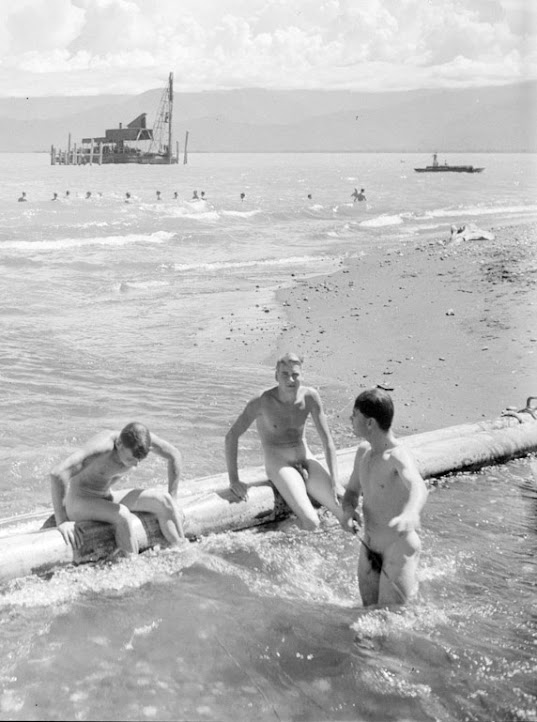Max Dupain
Max Dupain (1911-1992) was an Australian photographer. UPDATE: I found some more photos by Dupain and replaced the last photo in this post with a better one.
The 1938 self-portrait above is interesting for the big, heavy camera it shows him with.
Dupain is best known for this 1937 photo, called Sunbaker, that has become an iconic Australian image. It shows his friend Harold Salvage lying on the sand at Culburra Beach in New South Wales. By the way, what Australians call sunbaking is what Americans call sunbathing. The Australian term is really more descriptive.
Here's a photo of Dupain, left, and Salvage, right, on the beach, taken by Dupain's girlfriend Olive Cotton, who was also a photographer.
Dupain took far more photos of nude females than nude males, but there are some nude males, especially on the beach. This 1931 photo is called Resting Nude.
Discus Thrower III, 1937, is a study of that classic subject. Again, the setting is the beach.
Dupain's artistic photography may have been self-satisfying, but it didn't pay the bills, so he also did commercial photography. This is from a 1936 ad for Kelvinator refrigerators. Why are the people dressed up for a formal white-tie event? To send the subliminal message: buy a Kelvinator and be like these elegant rich people.
This 1937 photo is called Doom of Youth. The name comes from a 1932 book that was an anti-industrial polemic. The combination of the wheels of mechanization and a crucified man implies that mechanization has doomed the country's youth to a bleak fate. The photo is a double exposure. I don't know if the wheel was meant to conceal the frontal nudity or (because you can see through the wheel) to highlight it.
Doom of Youth was one of several photos with crucified naked men. Here's another image of the same crucified man, plus a second man. What looks like inkblots or damage to the photo is a double exposure with a landscape of sand and rocks. The result, in my opinion, is not successful.
This 1938 photo called Group shows model Greta Lufberg and an unidentified naked man.
A male nude from 1938.
In 1939, after the outbreak of World War II, Dupain married his girlfriend Olive Cotton, but they divorced soon after. During the war, he served with the Royal Australian Air Force in both Darwin, Australia and Papua New Guinea in the camouflage unit, helping to create camouflage and to photograph it from the air to judge its effectiveness.
This 1943-1944 photo is from a set called Various New Guinea. These are presumably some soldiers on the beach. I cropped it to show detail. Unlike some other WWII photographers who took nude photos of their fellow soldiers whenever the opportunity presented itself, Dupain only took a few.
Those few appear to be his last nude male photos. After the war, his preference in subject material changed. He abandoned what he called the "cosmetic lie of fashion photography or advertising illustration.” I could find no nude male photos by Dupain after the war.











9 comments:
It's interesting that he lost interest....
What kind of photos did he take after the war?
He sure had some swings in his taste. Did he ever do any full frontal shots of naked males?
These are very nice. Thanks!
It seems he did portraits, documentary photos, including trips to the interior and north coast of Australia, and photos of buildings and cityscapes.
Only a few. Dupain was not gay, and his posed studio shots of nude males avoid frontal views. There are a few unposed frontal shots. I just came across some more Dupain photos, and I replaced the last photo in this post with another wartime photo, an unposed frontal shot on the beach in New Guinea.
Strangely enough, my favorite of the lot is the Kelvinator.
Jerry, I know you appreciate well-done photographic lighting, and I think this qualifies. It could almost be an art photo, if it weren't for the refrigerator in the middle of it.
This is a really interesting series. I'm familiar with Max Dupain through the beautiful 'Sunbaker' photograph. To me, it's timeless and captures the essence of masculine beauty. Thanks again for an excellent series.
Peter
Post a Comment